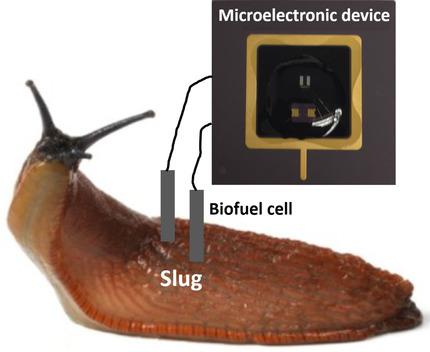当前位置:
X-MOL 学术
›
ChemPhysChem
›
论文详情
Our official English website, www.x-mol.net, welcomes your feedback! (Note: you will need to create a separate account there.)
A Microelectronic Sensor Device Powered by a Small Implantable Biofuel Cell.
ChemPhysChem ( IF 2.9 ) Pub Date : 2019-09-23 , DOI: 10.1002/cphc.201900700 Paolo Bollella 1 , Inhee Lee 2 , David Blaauw 2 , Evgeny Katz 1
ChemPhysChem ( IF 2.9 ) Pub Date : 2019-09-23 , DOI: 10.1002/cphc.201900700 Paolo Bollella 1 , Inhee Lee 2 , David Blaauw 2 , Evgeny Katz 1
Affiliation

|
Biocatalytic buckypaper electrodes modified with pyrroloquinoline quinone (PQQ)‐dependent glucose dehydrogenase and bilirubin oxidase for glucose oxidation and oxygen reduction, respectively, were prepared for their use in a biofuel cell. A small (millimeter‐scale; 2×3×2 mm3) enzyme‐based biofuel cell was tested in a model glucose‐containing aqueous solution, in human serum, and as an implanted device in a living gray garden slug (Deroceras reticulatum), producing electrical power in the range of 2–10 μW (depending on the glucose source). A microelectronic temperature‐sensing device equipped with a rechargeable supercapacitor, internal data memory and wireless data downloading capability was specifically designed for activation by the biofuel cell. The power management circuit in the device allowed the optimized use of the power provided by the biofuel cell dependent on the sensor operation activity. The whole system (power‐producing biofuel cell and power‐consuming sensor) operated autonomously by extracting electrical energy from the available environmental source, as exemplified by extracting power from the glucose‐containing hemolymph (blood substituting biofluid) in the slug to power the complete temperature sensor system and read out data wirelessly. Other sensor systems operating autonomously in remote locations based on the concept illustrated here are envisaged for monitoring different environmental conditions or can be specially designed for homeland security applications, particularly in detecting bioterrorism threats.
中文翻译:

由小型可植入生物燃料电池驱动的微电子传感器设备。
分别制备了吡咯并喹啉醌(PQQ)依赖性葡萄糖脱氢酶和胆红素氧化酶修饰的生物催化巴克纸电极,用于葡萄糖氧化和氧还原,将其用于生物燃料电池。在含葡萄糖的模型水溶液中,人血清中以及作为植入装置的生活在灰色花园garden中(Deroceras reticulatum),测试了一种小型(毫米级; 2×3×2 mm 3)基于酶的生物燃料电池。),产生2-10μW的电功率(取决于葡萄糖源)。配备可充电超级电容器,内部数据存储器和无线数据下载功能的微电子温度传感设备是专门为生物燃料电池激活而设计的。设备中的电源管理电路允许根据传感器的运行活动来优化利用生物燃料电池提供的电源。整个系统(发电的生物燃料电池和能耗传感器)通过从可用环境中提取电能来自主运行,例如,从from中含葡萄糖的血淋巴(用血液代替生物流体)中提取电力来为整个系统供电。温度传感器系统并无线读取数据。
更新日期:2019-09-23
中文翻译:

由小型可植入生物燃料电池驱动的微电子传感器设备。
分别制备了吡咯并喹啉醌(PQQ)依赖性葡萄糖脱氢酶和胆红素氧化酶修饰的生物催化巴克纸电极,用于葡萄糖氧化和氧还原,将其用于生物燃料电池。在含葡萄糖的模型水溶液中,人血清中以及作为植入装置的生活在灰色花园garden中(Deroceras reticulatum),测试了一种小型(毫米级; 2×3×2 mm 3)基于酶的生物燃料电池。),产生2-10μW的电功率(取决于葡萄糖源)。配备可充电超级电容器,内部数据存储器和无线数据下载功能的微电子温度传感设备是专门为生物燃料电池激活而设计的。设备中的电源管理电路允许根据传感器的运行活动来优化利用生物燃料电池提供的电源。整个系统(发电的生物燃料电池和能耗传感器)通过从可用环境中提取电能来自主运行,例如,从from中含葡萄糖的血淋巴(用血液代替生物流体)中提取电力来为整个系统供电。温度传感器系统并无线读取数据。


























 京公网安备 11010802027423号
京公网安备 11010802027423号